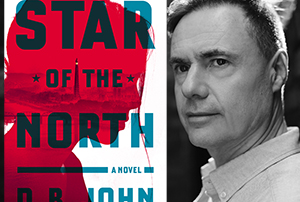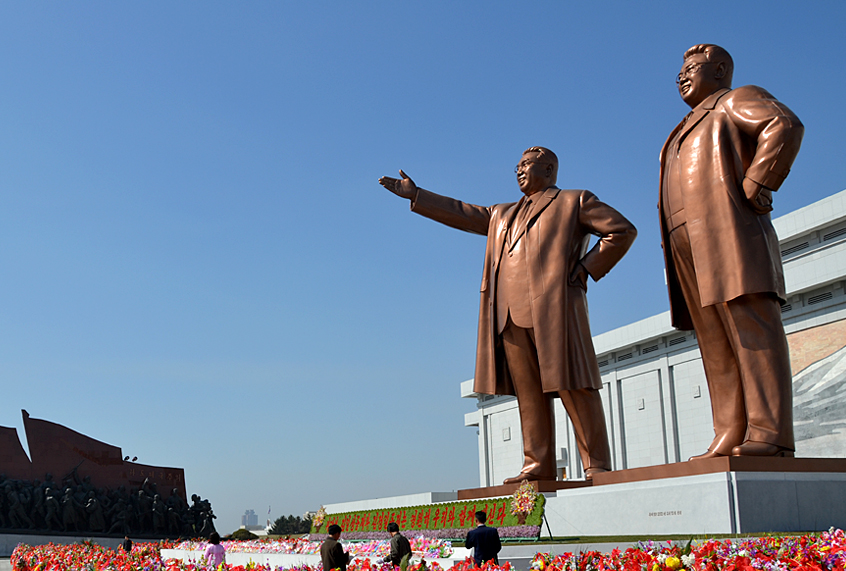When it comes to vacation destinations, few people’s bucket lists include North Korea, but I had long wanted to make this dark, fascinating place the subject of a novel. Short of writing science fiction, it is probably the most alien society in the world today in which to set a story. It was the dramatic news from Pyongyang of December 19, 2011, that made me take the plunge. At noon on that day, Ri Chun-hee, the regime’s notorious news anchorwoman, appeared on state television dressed in black. Her voice quavering with emotion, she broke the news that Kim Jong Il, the Dear Leader who had ruled the country for 17 years, had died. Before she had even finished speaking, the shockwaves were spreading throughout the country. I watched footage of crowds pouring into the streets in an epic display of public grieving that seemed to grow more extreme by the hour.
North Korea is the world’s last remaining totalitarian tyranny. The rules of human behavior are different there. I knew that no one had ordered these people to mourn. No one had needed to. Everyone understood that severe punishment awaited those whose eyes were dry.
I arrived in the hermit kingdom four months later, in spring, as part of a small, tightly controlled tour group: twelve tourists, two official guides — “No photos!” — and a driver. I should not have been surprised that such an odd destination would attract some strange travel companions. One was a retired British surgeon traveling with his anesthetist of 30 years. Neither, as far as I could tell, had brought a change of clothing. Both shared a fetish for the uniformed girls at Pyongyang’s intersections, famous for their robotic traffic-directing hand signals. Others in the group included a quiet retired couple from Melbourne, Bob and Sue, who had never set foot outside Australia, but were making North Korea their first foreign trip.

By chance, we had arrived at a highly symbolic time for North Korea. For years, Party propaganda had been heralding 2012 — the centenary of the birth of Kim Il Sung, the self-styled Great Leader and father of Kim Jong Il — as the momentous point at which the country would fulfill its destiny of becoming a “strong and prosperous nation.” The celebrations were unprecedented in scale — the military parades were just for starters; they were followed by a week of song-and-dance spectaculars, mass public oath-takings, choral extravaganzas numbering thousands of singers, a firework display costing millions of dollars that lasted one hundred minutes (a minute for each year of Kim’s life), all this in a country that struggled to feed its children and keep the lights on.
The regime had never before experienced such an influx of foreigners. Accommodation in Pyongyang’s meager hotel facilities proved a stretch. Our first night was spent on the rock-hard mats of the sprawling Ryanggang Hotel, built in 1989 when Pyongyang had hosted the World Festival of Youth in reaction of to the 1988 Seoul Olympics (which it had boycotted). The event had bankrupted the country and the hotel had not been used since. On the second day, our hotel was in Pyongsong, a satellite city to Pyongyang, normally off-limits to outsiders. People there, wholly unused to Western visitors, gawped at us as if we had just stepped off the set of “Star Wars.”
Every North Korean city has a bronze colossus of the Great Leader, so it was in Pyongsong on the big day itself, April 15, that we were obliged to join an immense crowd of Young Pioneers, city officials in Mao suits, factory workers, army cadets and women in long hanbok dresses, all advancing en masse in silence, thousands abreast, flowers in hand, toward the giant statue. It remains one of the oddest experiences of my life — redolent more of the cult of Amun-Ra in ancient Egypt than of anything from the old Soviet bloc.
The hotel in Pyongsong was equally makeshift. Bathrooms flooded; toilets wouldn’t flush. We were awoken the next morning by the daily siren that sends all citizens, communally, marching to work behind unit leaders holding red banners.
I knew, of course, that an official tour would include only what the regime intended us to see — a model collective farm in Hamhung; the vast West Sea Barrage at Nampo, those striking parts of Pyongyang that resemble a vast stage set, all uncompromising angles and monuments. This impression was enhanced by the fact that all the citizens that passed within our vicinity behaved like movie extras. The expression on their faces reminded me of that quiet optimism it was advisable to wear when facing the telescreens in “1984.” It made me wonder about the inner lives of North Koreans. Did they ever risk voicing doubts, even to those closest to them? How did they carve out any sort of private life, away from the surveillance and the cult? How did they live?
For decades, the country’s isolation and the extreme political control it exercised over every facet of people’s lives, public and private, allowed it to maintain its own reality of sorts, its own universe. But with so many foreigners in the country that April, the regime’s grip was visibly slipping. The things it went to great lengths to deter visitors from doing: peeking behind the scenery, interviewing the actors, questioning the script, became briefly possible. The road from Pyongsong into the capital, for example, was cratered and potholed; men squatted peasant-style on the verges, doing nothing, waiting for nothing. Farmers tilled rock-strewn fields with oxen. We passed a ruined, once-famous factory. Women washed clothes in the freezing brown meltwater of a river. “No photos! No photos!” Here was raw poverty, the reality behind the state’s facades.
Two weeks is a long time for a tourist in North Korea. The daily diet of official falsehoods soon became wearying. Most blatant of these was the repeated claim that South Korea started the Korean War on June 25, 1950. I wondered how the public here would react if they ever found out that their country’s founding myth, believed by all North Koreans, is a deliberate lie.
Most foreign visitors to North Korea are obliged to make the pilgrimage to this small village just outside Pyongyang. It was here that Kim Il Sung was born into a poor family on April 15, 1912. The sacred site has been preserved as a shrine. On a wooded hill nearby, one of our guides led us to a view of the Taedong River. A starry look came into his eyes as he began to recount yet another legend from Kim’s life. “It was in this spot,” he said, gazing into the distance, “that our Great Leader, as a young boy, would sit thinking so deeply upon the suffering of his people that the ox he was minding would find its own way home . . .”
North Koreans grow up with stories like this in the way that we in the West grow up with the Nativity and Easter — with one crucial difference. In North Korea, the stories may never be doubted, by anyone. The cult of Kim is central to the regime’s power structures. It tolerates no heresy.
For a writer setting a thriller in North Korea, a country where so much seems beyond belief to outsiders, this was not without irony. Just as we tourists were expected to accept cooked-up myths as historical truth, so I would be drawing from genuine factual material that was so much stranger than fiction it risked straining all credulity.
There has been much justified criticism of those who travel to North Korea. Tourism is, after all, a hard-currency earner for a regime that routinely sends hundreds of thousands of its own citizens to the gulag. And yet, when change comes to North Korea, as change inevitably will, it will be greatly accelerated by the growing trickle of outside information that enters the country from the prosperous modern world that surrounds it — information that the regime fights a losing battle to keep at bay. When my small tour group waved at a line of children on their way to school, and the children waved back, they saw for themselves we are not the snarling imperialist jackals of state propaganda cartoons. It was only a tiny change of perception, but a change nonetheless.

